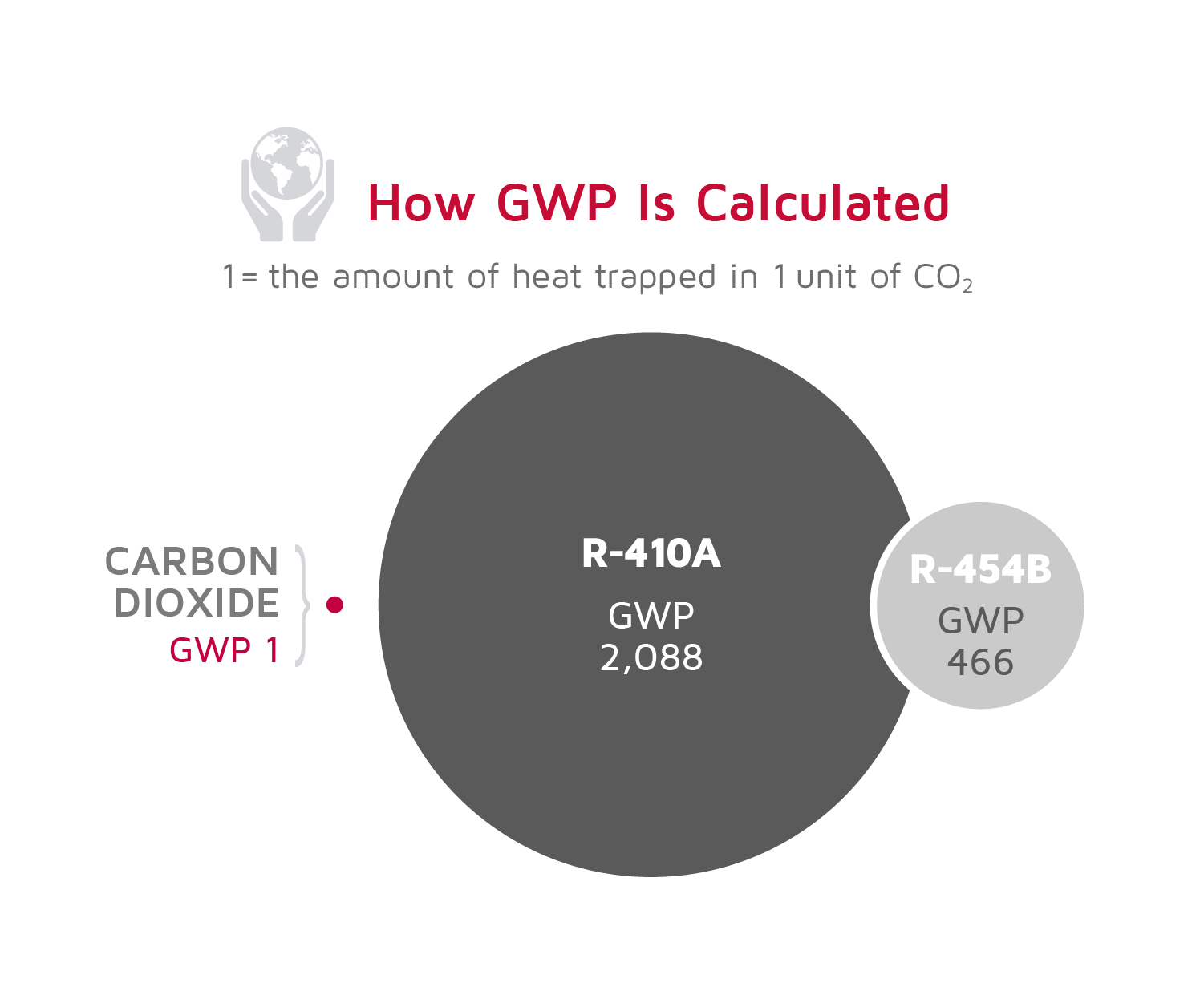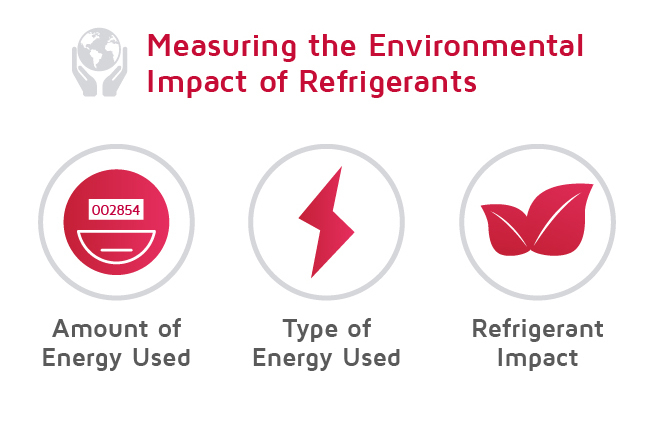Understanding GWP
GWP stands for global warming potential. It refers to a formula used to measure how much a substance contributes to global warming over a period of time. Specifically, it represents how much heat a substance traps when compared to CO2. Over the past decade, GWP scores have become a standard indicator within the HVAC industry of a refrigerant’s impact on the environment. Traditional refrigerants, such as hydrofluorocarbons (HFCs), have high GWP values, meaning they have a significant impact on climate change. Low-GWP refrigerants, on the other hand, have much lower GWP values, making them a more environmentally friendly choice.
What is GWP exactly?
You’re probably familiar with terms like carbon footprint, carbon emissions, or low-carbon energy, right?
In phrases like these, the term “carbon” is shorthand for “carbon dioxide” (CO2) – the predominant greenhouse gas. Of the four greenhouse gases, carbon dioxide represents about 80% of the problem globally. Because of this, most commonly used systems used to measure environmental impact, including GWP rely on CO2 as their primary reference point.

In simple terms, GWP is a measure of how much heat the gas emissions from a substance trap when compared with carbon dioxide. For example, R-410A refrigerant has a GWP of 2088. That means that just 1 unit of R-410A traps as much heat as 2088 units of CO2 – so R-410A traps 2088 times as much heat as CO2.
That’s a lot.
You can understand why we’re switching to R-454B, a newer Low-GWP refrigerant. R-454B has a GWP score of 466 – so it only traps 466 times as much heat as CO2. Still very high, but a huge improvement over R-410A.
Learn how the EPA defines Global Warming Potential (GWP) to learn more about how the EPA defines Global Warming Potential.
HVAC and the Environment
Based on their chemical makeup, refrigerants are inherently greenhouse gasses (GHGs). The high GWP scores of most present and past refrigerants means that their release into the atmosphere, on a per pound basis is immensely more harmful than simple CO2.
Including the effects of refrigerants, there are three primary ways HVAC impacts the environment. Through the amount of energy used by the equipment, the type of energy used by that equipment, and the impact of the refrigerant used.
In the 1980s scientists discovered a hole in the ozone layer, the layer of the atmosphere that protects us from the sun’s ultraviolet radiation. Additional studies revealed that certain chemicals used around the world, some used in everyday life had caused the damage. R-22 was identified as one of those and designated an Ozone Depleting Substances (ODS).

The global community came together in 1987 to address the threat to the ozone, signing the Montreal Protocol, an agreement to phase out ozone-depleting substances, including R-22.
International action to move away from ozone-depleting substances has been very successful. For their part, the US and European HVAC industries transitioned to R-410A, a new refrigerant with zero impact to the ozone in 2010. A recent assessment found signs that the ozone is recovering and expects to see a fully healed ozone layer later this century.
In much the same way, it’s become clear in recent years that the production and emission of greenhouse gases has begun impacting our atmosphere, and in turn, our climate. In response, the global community came together again in 2015 in hopes of repeating the successful outcome of 1987. The result was the Paris Agreement, a set of protocols and goals designed to incent changes that would help reduce emissions, mitigate greenhouse gas build up and reduce global warming.
Though the motivations remain the same, it’s been widely recognized that combatting global climate change is a much larger undertaking than addressing the ozone issue of the 1980s. Making progress toward zero emissions will take time and require changes both economically, and culturally across the world. For now, most of the industries effected will be taking incremental steps toward doing their part.
What progress means for the HVAC industry?
The Long-Term Transition: Moving toward Zero GWP
The EPA set into motion a schedule designed to move the HVAC industry toward reduced GWP refrigerants between 2022 and 2036.
This transition will happen in two ways; a scheduled phasedown of high GWP R-410a refrigerant combined with the implementation of new low-GWP refrigerants – eventually progressing into the use of natural refrigerants such as propane that pose little to no risk to the environment.

The R-410a phasedown process began in 2022. It started gradually but in 2025 ramps up with a 40% reduction in the amount of R-410a refrigerant produced or imported into the U.S. In addition, in 2025 the EPA will prohibit the production of new equipment that uses R-410a, requiring all new equipment to use new low-GWP refrigerants with a GWP score of 700 or less. The two primary low-GWP refrigerants that meet those requirements are R-32 and R-454B. Lennox has chosen R-454B as our 2025 Compliant Refrigerant.
And the 2025 shift is not the last major transition the industry experiences. Beyond 2025, we will see continued phase down of R-410a with a 70% reduction in 2029. We can also expect another reduction in the GWP requirements of residential and commercial refrigerants in 2034 that will likely require a move to natural refrigerants like propane.
Today’s Transition: Moving to Low-GWP Refrigerants
As a part of our pledge to make decisions that are good for homeowners, good for dealers, and good for the environment, we’ve updated our entire product lineup to use our 2025 Compliant Refrigerant – R-454B.
With a 78% lower GWP than previous refrigerants, it complies with updated EPA regulations and is formulated to provide excellent, reliable performance for years to come.
Benefits of Lennox’s 2025 Compliant Refrigerant
- Zero Effect on the Ozone
Compared to refrigerants with high levels of HFCs, low-GWP refrigerants are non-ozone depleting and have lower global warming potential.
- Chemical Composition
Low-GWP refrigerants are composed of elements and compounds that produce minimal greenhouse gas effects, such as hydrogen, carbon, and fluorine. Refrigerants with high GWP often contain chlorine.
- Short Atmospheric Lifetime
Refrigerants with shorter atmospheric lifetimes tend to have a lower GWP level as they don’t stay in the atmosphere for extended periods, reducing the overall impact on global warming.
Visit the EPAs website to learn more about the transition to low-GWP alternatives.
What does the R-454B transition mean to you?
If your current system uses R-410A or R-22 refrigerant, no immediate action is required. The phasedown schedule stretches out to 2036, a timeline that allows homeowners to upgrade or replace their systems with R-454B equipment units at a time that’s convenient to them and based on the life of their system. As most systems have a lifespan of 10-15 years, the majority of homeowners should make the transition naturally within the phasedown timeline.
When the time comes, whether it’s an emergency replacement or a planned upgrade, every homeowner’s situation will look different. Homeowners should discuss their system replacement options with a local dealer or technician to understand which system will best suit their needs.
As the phasedown schedule progresses, our dealers and technicians continue to receive extensive ongoing training and new product education to ensure they can answer your questions and provide the best experience possible. Your local Lennox dealer will be well equipped to help service and advise you as the transition calendar moves forward.



